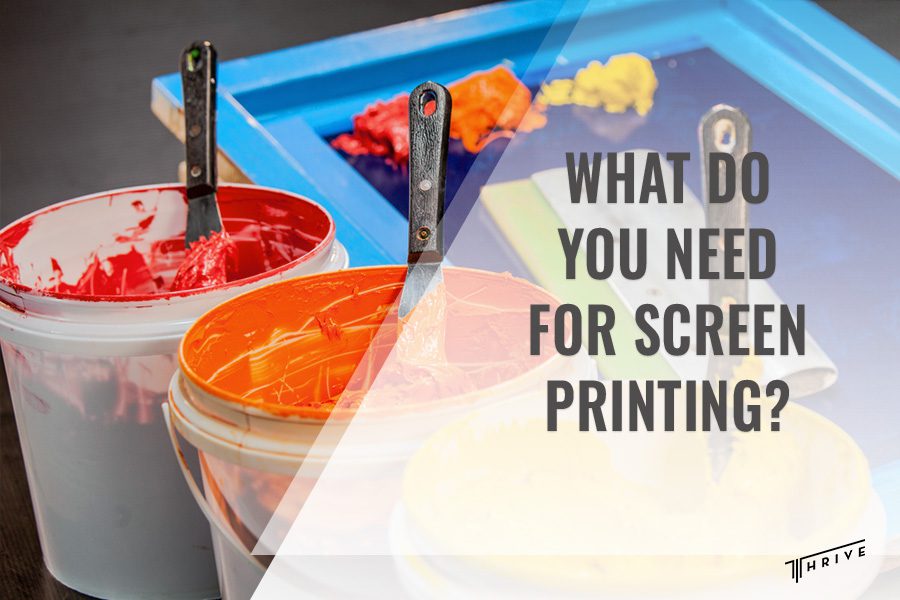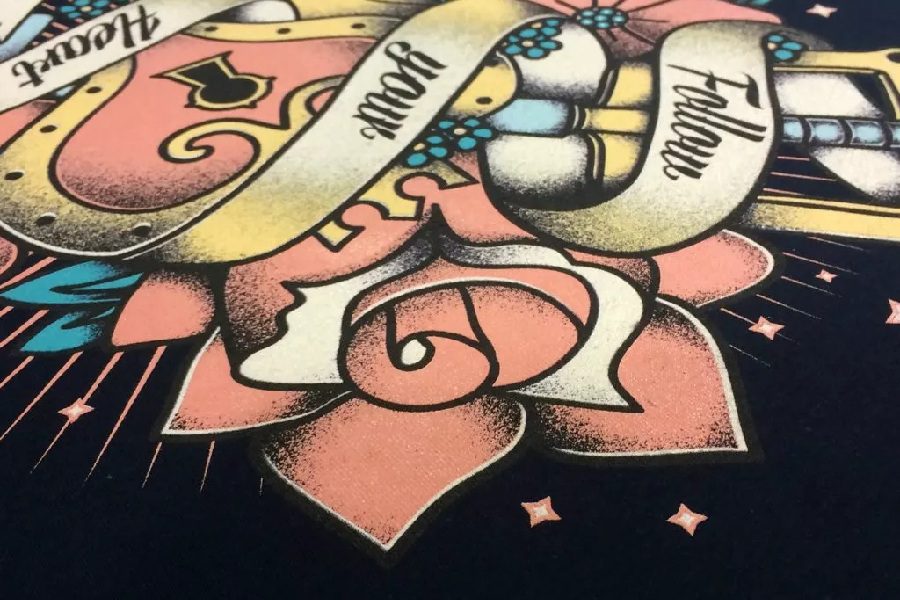
Screen printing is a fantastic way to bring your designs to life, whether you’re crafting custom apparel, eye-catching posters, or unique art prints. But what do you need for screen printing? It’s essential to gather the right equipment and supplies to embark on this creative journey.
In this article, we’ll provide a quick and easy guide to the essentials of screen printing. Whether you’re a beginner or a seasoned pro, we’ve got you covered. Before diving into the world of screen printing, let’s get to know the necessary tools that you will need to print your designs.
These items are like the building blocks of your screen printing projects, and understanding their role is key to crafting stunning prints, whether it’s on T-shirts, posters, or more. So, let’s keep it simple and practical as we delve into what you need and why it matters.
What Do You Need for Screen Printing?
Your workspace is the foundation of your screen printing setup. At the heart of it all is the Screen Printing Press, which holds everything together, ensuring precision and consistency in your prints. It’s your printing station, and it’s where the magic happens.
To complement the press, you’ll need Screen Frames, which hold the mesh screens that carry your stencil. These frames come in various sizes to accommodate different print dimensions.
Speaking of screens, Mesh Screens are your canvas for designs. The mesh count (threads per inch) varies and affects the level of detail you can achieve, so choosing the right mesh is crucial.
Ink is, of course, at the core of your creations. Depending on the material you’re printing on, you’ll choose from Inks such as water-based, plastisol, or discharge inks. Here is a complete list of essentials you will need to get started with screen printing.

Screen Printing Essential Checklist
- Screen Printing Press
- Screen Frames
- Mesh Screens
- Squeegees
- Inks
- Emulsion and Sensitizer
- Exposure Unit
- Darkroom Setup
Essential Equipment for Screen Printing
Screens and Frames
1. The Role of Screens and Frames: Screens and frames are the fundamental building blocks of screen printing. Screens are made of a mesh material that holds your stencil, while frames provide structural support. Together, they create the canvas for your designs.
2. Different Screen Mesh Options: Screen mesh comes in various counts, measured in threads per inch. We’ll explore how mesh count impacts your prints, from achieving fine details to laying down thicker ink layers for bold designs.
Squeegees
1. The Function of Squeegees: Squeegees are like the conductor’s baton in screen printing, responsible for pushing ink through the screen and onto your chosen surface. We’ll break down their essential role in the printing process.
2. Choosing the Right Squeegee: Not all squeegees are created equal. We’ll discuss the importance of selecting the appropriate squeegee type and size based on your specific printing needs, whether it’s fine art or high-volume production.
Exposure Unit
1. Creating Stencils with Exposure Units: Exposure units are a critical step in transforming your design into a functional stencil. We’ll explain how these units use UV or LED light to harden the emulsion on your screens, ensuring your design is ready for printing.
2. Variations in Exposure Units: Exposure units come in different flavors, from traditional UV exposure units to more modern LED options. We’ll explore the variations and help you understand which one suits your workflow best.
Printing Press
1. The Printing Press as a Critical Tool: The printing press is the workhorse of screen printing, providing stability and precision. We’ll introduce you to its pivotal role in achieving consistent and high-quality prints.
2. Types of Printing Presses: There’s no one-size-fits-all when it comes to printing presses. We’ll walk you through the differences between manual and automatic presses, offering insights into which option aligns with your printing aspirations, whether you’re starting small or aiming for large-scale production.
Essential Supplies for Screen Printing
Inks
Inks are the colorful heart of your screen printing venture. There are different types of inks to choose from, like plastisol and water-based inks. Each has its unique qualities. Plastisol is known for its durability, while water-based inks are eco-friendly and offer a soft feel.
When picking ink colors, think about what suits your design best. Bright and bold or subtle and muted – it’s your choice!
Emulsions
Emulsions are like the magic potion for creating stencils on screens. They make it possible to transfer your design onto the screen with precision.
There are two main types: photoemulsion and direct emulsion. Photoemulsion is excellent for intricate designs, while direct emulsion allows more artistic freedom. Your choice depends on your design and preferences.
Stencil-making Materials
Creating the perfect stencil is crucial for sharp prints. You’ll need materials like films, vellum, or digital transparencies. These materials help you transfer your design onto the screen accurately. Remember, the quality of your stencil materials can make a big difference in the final result.
Cleaning and Reclaiming Supplies
After printing, screens need a good cleaning for reuse. Cleaning supplies like screen cleaners and emulsion removers are essential for this. Proper cleaning and reclaiming not only save you money but also help maintain the quality of your screens.

Optional Accessories and Advanced Equipment
While the essentials cover the basics, there are some optional accessories and advanced equipment that can take your screen printing game to the next level. Let’s explore these add-ons:
Dryers
Dryers play a crucial role in curing ink on your printed items. They make sure the ink dries properly and stays vibrant. There are two main types: conveyor dryers and flash dryers.
Conveyor dryers are like a magic tunnel where your items go through, and the heat does the job. Flash dryers are like spot treatments for quick drying. The choice depends on the scale of your operation and the items you’re printing.
Exposure Calculator
Exposure calculators are like your secret weapon for precise exposure times. They help you get your stencils just right, which means your prints will be spot-on. If you’re all about top-notch quality, having an exposure calculator in your toolkit is a wise move. They take the guesswork out of the equation and give you consistent results.
Screen Tension Meter
Maintaining proper screen tension is essential for achieving crisp prints. Screen tension meters are like your screen’s personal fitness tracker – they measure the tension to make sure it’s in the optimal range.
Keeping the right tension ensures your screens are ready to create sharp designs time and time again. It’s a small tool that can make a big difference in your printing quality.
Workspace and Safety Considerations
When embarking on your screen printing journey, it’s essential to create a workspace that promotes efficiency and ensures your safety. While it’s important to ask, ‘what do you need for screen printing, ’ don’t forget to take crucial safety precautions when setting up your workspace.
Setting Up Your Workspace
- Organization is Key: A well-organized workspace is the heart of productive screen printing. Invest in shelving units, storage containers, and labeling to keep screens, inks, and supplies easily accessible. A clutter-free workspace leads to smoother printing sessions.
- Ventilation Matters: Adequate ventilation is vital, especially when working with inks and chemicals. Ensure your workspace has proper ventilation to dissipate fumes and maintain a fresh, breathable atmosphere.
Safety Precautions
- Protective Gear: Safety should always come first. Wear protective gear like gloves, aprons, and safety goggles when handling inks, chemicals, or cleaning supplies. These precautions shield you from potential skin contact or splashes.
- Chemical Awareness: Be mindful of the chemicals used in the screen printing process. Store them in clearly labeled containers and follow safety instructions when handling them. Always have an eye wash station and emergency shower within reach, just in case.

If You Want to Learn More: How Much is Screen Printing?
Conclusion
Screen printing is an exciting creative endeavour that begins with having the right equipment and supplies. From screens and inks to a well-organized workspace, these essentials lay the foundation for your printing journey.
This article brings you a better understanding of all the right tools to bring your designs to life in vibrant, tangible ways. Understanding the functions and choices of these materials is key to achieving your desired results.
Now, gather your essentials, set up your space, and start your screen printing adventure!
Robert Fisher is the founder and CEO of Thrive Screen Printing and brings extensive experience in the screen printing and fulfillment industry.

